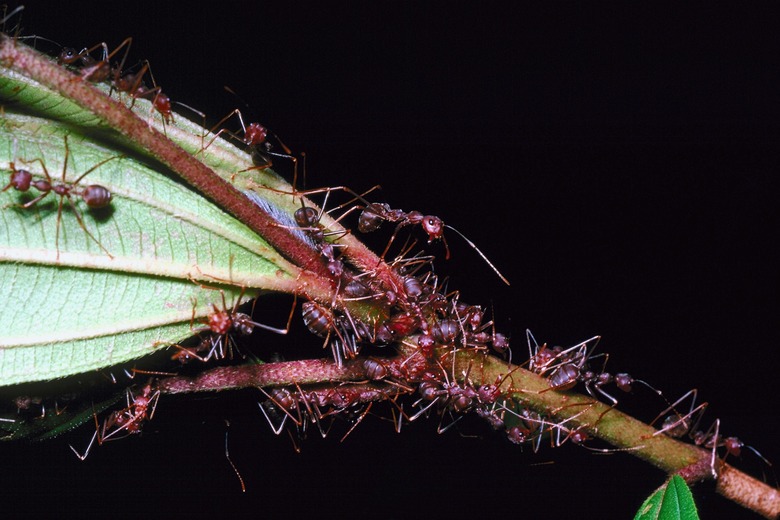Ants On Crape Myrtle
Resembling unlikely buddies on your kids' playground, ants and aphids are often allies. If you see a trail of ants climbing your crape myrtle (Lagerstroemia indica), they may be on a treasure hunt for a sweet treat called "honeydew." Their pals, the aphids, make this honeydew, which the ants prize so much that they're willing to protect the aphids like bodyguards to ensure a steady supply of treats.
Aphids
Step 1
Wherever crape myrtles grow in U.S. Department of Agriculture plant hardiness zones 7a through 9a, they are vulnerable to aphid damage. These pests typically hide on the undersides of the leaves so they are less visible to predators. The aphids feed on cell sap by extracting it through their stylet mouthpiece like a hypodermic needle. Among numerous aphid species, the crape myrtle aphid (Tinocallis, or Sarucallis, kahawaluokalani [Kirkaldy]) is the only one that feeds on crape myrtles. The aphids excrete a sugary waste product called honeydew that is irresistible to ants.
- Resembling unlikely buddies on your kids' playground, ants and aphids are often allies.
- If you see a trail of ants climbing your crape myrtle (Lagerstroemia indica), they may be on a treasure hunt for a sweet treat called "honeydew."
Ants
Step 1
Ants form an unusual partnership with aphids from which they both benefit — a phenomenon called mutualism. In return for protecting aphids by fending off their predators, ants are paid for their service with a harvest of honeydew, which is a high-carbohydrate food source for them. However, their benefit is a detriment to crape myrtles. The predators that the ants deter are beneficial insects that eat aphids and help protect crape myrtles from the feeding damage the aphids inflict.
Aphid Life Cycle
Step 1
Aphids have an unusual ability to reproduce sexually and asexually. Aphid eggs hatch in spring as the crape myrtle leaf buds are opening. All the hatchling aphids are females that subsequently reproduce asexually and bear live young, all of which are also female. Multiple, successive generations are produced during the same season, repeating the pattern of asexual reproduction and all-female offspring. The shorter days in autumn trigger a photoperiodic response in female aphids that enables them to produce male and female live young. The males and females mate with each other, resulting in eggs that the females deposit into bark crevices on crape myrtle stems. These eggs overwinter until the following spring, when the life cycle begins again. The protection that ants offer, coupled with the prolific reproductive capabilities of aphids, is a double whammy to the health of crape myrtles.
- Ants form an unusual partnership with aphids from which they both benefit — a phenomenon called mutualism.
- The protection that ants offer, coupled with the prolific reproductive capabilities of aphids, is a double whammy to the health of crape myrtles.
Control
Step 1
Ant management is crucial to mitigate aphid damage. Left unchecked, ant populations enable aphid populations to run rampant, resulting in heavy feeding that injures crape myrtles. The answer is as simple as wrapping crape myrtle trunks with sticky flypaper to stop ants from reaching the leaves. With their protective bodyguards held at bay, aphids become lunch for their natural predators, such as ladybugs and lacewings. To protect tree trunks, first wrap them with fabric, and then secure the flypaper around the fabric. Position the sticky paper out of reach of inquisitive little hands so you don't end up with a tangled mess.
